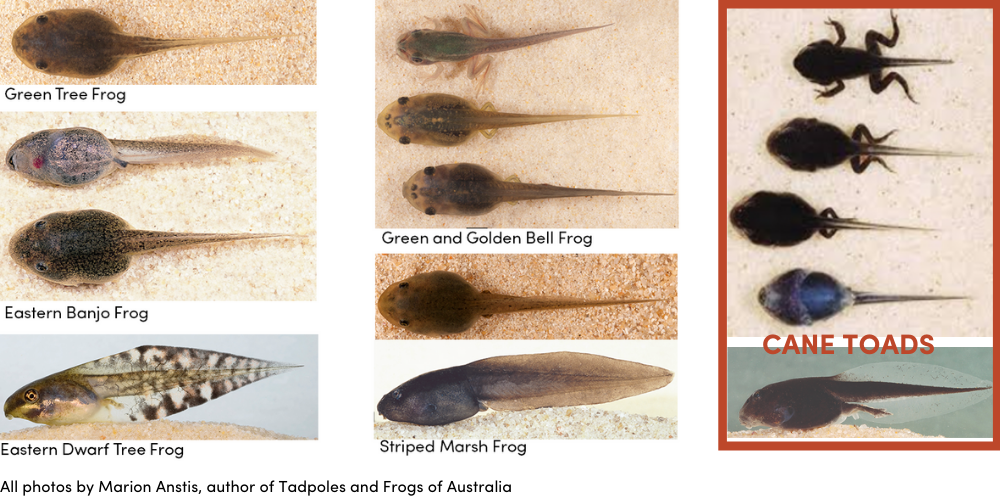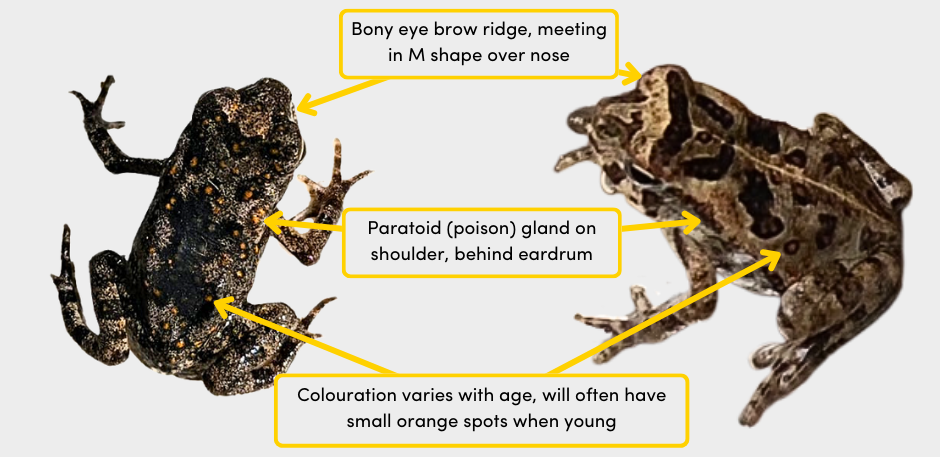Cane Toad or native frog?
There are over 240 species of native frog in Australia, but only one invasive toad: the Cane Toad (Rhinella marina). It’s important to know what to look for to confirm Cane Toad ID at every life stage.
If you’re not sure, leave the animal alone in the environment. It can help to take a picture and have an expert confirm what species it is to learn for next time, but please don’t keep animals captive or euthanise if you’re unsure. We’re happy to help with identification requests to help you learn, just send your photos to [email protected] and we will respond as soon as we can!
How can I tell if the eggs in my garden are Cane Toad eggs or frog eggs?
Cane Toads have a breeding season, breeding in times of warm, wet and humid weather. The exact timing of this varies across Australia due to differences in climate. In South East Queensland Cane Toads will breed during summer months, however their breeding season is longer in Northern Australia.
Eggs are the easiest stage of the Cane Toad lifecycle to control, because they are easy to distinguish from frog eggs and you can remove thousands at once! Make sure you can tell the difference before pulling them out of the water, as both frog and Cane Toad eggs need water to survive.
Cane Toad eggs
Cane Toad eggs are in long jelly strings which come to rest under the water and among vegetation. Female Cane Toads will lay between 8000 and 35,000 eggs in one clutch and may lay up to 2 clutches per year. Cane Toad eggs have a complex toxin profile and are highly toxic. Eating Cane Toad eggs can kill native frog tadpoles and other animals. They will hatch into tadpoles very quickly in just 3 days, so if you see them in the water, pull them out!

Frog eggs
With more than 240 species of native frog in Australia, their eggs will vary depending on the species. However, many are in lumps of jelly or foam. Most frogs lay their eggs in the water among vegetation, although some will lay their eggs in trees or on land. Frog egg clutches are typically much smaller than that of toads, ranging from just 16 for the Corroboree Frog to nearly 4000 for the Bleating Tree Frog. Hatching times vary between species.
How can I tell if the tadpoles in my garden are Cane Toad tadpoles or frog tadpoles?
Cane Toad tadpoles are easy to identify with a few physical and behavioural indicators. They are the perfect stage to control with our Cane Toad Tadpole Trap and Lure technology, which removes hundreds if not thousands before they grow up to cause damage. Don’t ID on colour alone, as some native frog tadpoles can look similar at a first glance. Tadpoles can be hard to get a good look at in a large waterbody, so catch one in a glass for a good look.
Cane Toad tadpoles
Cane Toad tadpoles can be identified by their appearance and behaviour. They will swam together in large numbers, in shallow, warm water. Toad tadpoles are jet black with an opaque sheen to their belly and they will grow to about 30mm in size. They have black tails with a clear frill which makes their tails appear quite slim. Their eyes are placed on the top of their heads and they will already have a hint of that strong ridged brow developing which makes them quite bulky and diamond shaped in appearance, widest at the gills. Another helpful clue, is that Cane Toad tadpoles have opaque narial pits (nostrils).

Native frog tadpoles
Native frog tadpoles show different behaviour and physical features than toad tadpoles. Frog tadpoles are more independent than Cane Toad tadpoles and do not swarm unless they are forced to (by a small waterbody for example). They come in a variety of colours, depending on the species, ranging from browns to greens and beige and will sometimes have spots or striped patterns. They have colouration in their tail frill, varying again depending on the species. Native frog tadpoles are a variety of shapes and sizes, although are often larger than Cane Toad tadpoles. Some of them will look similar to cane toad tadpoles like the spotted marsh frog tadpole which is a chocolate brown colour, almost black, so make sure you don’t ID on colour alone.


How do I know if I have a juvenile Cane Toad or small native frog?
If you are new to the amphibian world, this can be the hardest stage to be ID confident in. However, once you get more familiar with Cane Toads and native frogs, you will find that you are able to tell them apart, keep learning and don’t remove any animals if you’re not sure.
Juvenile Cane Toad ID
Juvenile toads can vary in size, colour and body shape depending on their age and stage of development. Juvenile Cane Toads are diurnal, meaning they are active during the day as well as night.
Like adult Cane Toads, the key identifying features are the paratoid gland and the bony eye brow ridge, meeting in an M over the nose. These features are still developing in young toads, so can be small and hard to see.
Their colour varies greatly, being dark when they leave the water and becoming lighter and more mottled as they grow. The spots can become more defined as they begin to reach sexual maturity at about 18 months of age. Cane Toads will often, but not always, have bright orange spots when they are young.
Juvenile or baby Cane Toads are very quick, so can be tricky to catch. They often leave the water at the same time, so metamorph toads can often be seen in huge numbers after a big breeding event, earning the name “moving carpet”.




Small native frogs
Young frogs or small frogs such as the Common Eastern Froglet in the picture above come in a great variety of colours, shapes, sizes and patterns. Some of these frogs may even be full grown, but are still small once they’ve reached maturity and may look similar to an untrained eye.

Do I have an adult Cane Toad or native frog?
There are over 240 different species of native frog in Australia, but the Cane Toad is the only species of toad in Australia. This means there are a few key things to look for to identify whether you have a Cane Toad or native frog. It’s always important to use at least three features to ID Cane Toads, as some species of frogs share some, but not all of these features.
Adult Cane Toad

Cane Toads are most active at night after dusk, during warmer, summer months. During the day, Cane Toads hide under rocks, logs and leaves. Sometimes they will even burrow underground! They emerge after dusk, coming out to feed and search for potential mates. They can commonly be found on lawns, patios, around houses or streets with lighting – anywhere where there are plenty of insects to eat.
Cane Toads spend most of their life on land but need water to breed. Cane Toads have a breeding season, which is during summer months. Warm, humid weather is perfect for Cane Toads to mate! Cane Toads like easily accessible, still water. This means dams, ponds, flood-plains and slow running creeks are perfect breeding grounds. Male toads will sit in the water and call out to females, who will make their way down to the water when they become gravid (have developed eggs that are ready to lay).
Ever wondered why you don’t see Cane Toads in winter? Cooler weather means Cane Toads will go into torpor, a natural amphibian state similar to hibernation.

The images above are all Cane Toads and demonstrate how varied their appearance can be in terms of colour, pattern and physique. This is why it’s important to use the paratoid gland and bony eye brow ridge to first ID whether you have an adult Cane Toad or native frog.
Some native frogs can look similar to Cane Toads and share secondary ID features. Can you tell the difference?

Common questions
Why shouldn't I pick up a potential Cane Toad so I can identify it?
It’s best to avoid handling frogs in case your hands have perfumes, creams, soap or other toxins on them. Leave the animal on the ground while identifying it, and if you’re not sure, leave it alone and take a photo so you can learn for next time.
How can I help encourage frogs at home?
Where can I learn more about frogs?
There are many great resources to help you learn more about Australia’s native frog species. Some of our favourites are:
- ‘Frog ID’ app: Frog ID is a citizen Science program started by the Australian Museum. It has several great features that will help you to ID frogs, including call recording and ‘near me’, which shows you all the frogs that have been found in your area.
- Tadpoles and Frogs of Australia by Marion Anstis: Essential reading for the frog enthusiast. This book by Marion Anstis has been described as ‘the most comprehensive and thorough treatment of a continental frog fauna that there has ever been’. Includes detailed information and photographs of Australia’s frog species from egg to adult.





